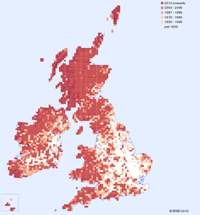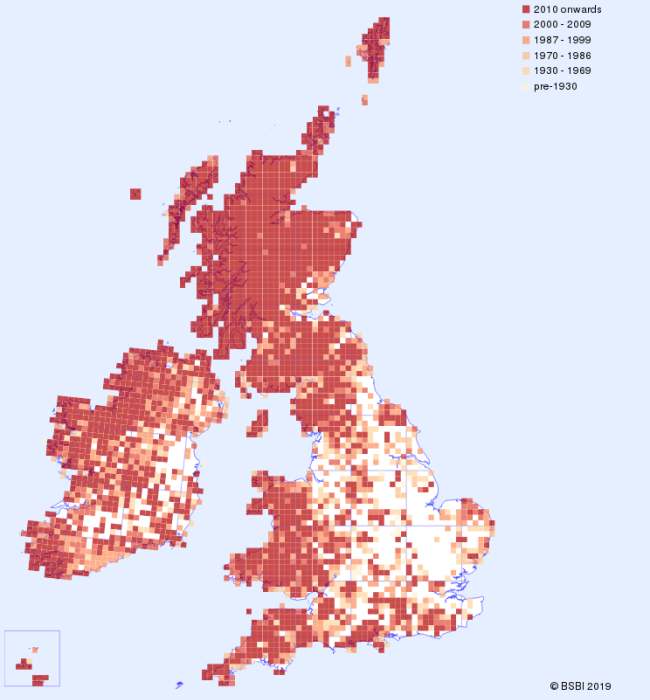This lovely orchid is a close relative of the Common Spotted-orchid Dactylorhiza fuchsii. Heath Spotted-orchid is more tolerant of acid habitats than its close relative and, as its name suggests, is mostly found on moorland and heaths. It is also tolerant of the damper, peaty soils found on the margins of bogs, but less tolerant of shade than Dactylorhiza fuchsii only growing successfully in woodland in open areas where there is plenty of light. Widespread in Britain and Ireland, Heath Spotted orchid is more localised in the south and south east of England and in southern Ireland. Its real strongholds are in the west and north, and so the best displays are usually to be found in Wales, Scotland and Northern Ireland. This orchid usually flowers from mid May until the end of July.
| Distribution Map |
Key Features |
 |
Records for the Heath Spotted-orchid from BSBI are shown on the map with most recent in front. (Hover the mouse over the small map to expand it.)
CLICK HERE to visit the BSBI website page for updated data and
maps with separated data for individual record periods.
|
Plant: 4 to 50cm tall, but more commonly between 10 and 25cm. (Very tall plants are likely to be hybrids.) The stem is pale green, flushed purple towards the tip, faintly ridged.
Leaves: up to 5 narrow, keeled and pointed sheathing leaves crowded at the base of the stem; they can be either unspotted or marked with dark spots.
Bracts: green, washed purple at the margins and tip; tapering to a point.
Flowers: up to 50 on a robust plant, but more commonly from 5 to 20 held on the inflorescence, which is pyramidal when flowering begins but becomes more oval as more of the flowers open. The flowers vary in colour from almost white to pale pink or almost purple. The upper sepal and petals form a hood over the lip, which is broad, sometimes almost round, shallowly divided into three lobes and variously marked with dots and loops. The margins of the lip are ruffled. |
Image Gallery for Heath Spotted-orchid Dactylorhiza maculata
| Pollination |
Taxonomy & Hybrids |
Seed set of Dactylorhiza maculata is good, and the flowers are pollinated by a variety of bees and flies. |
The specific name maculata means 'spotted'.
The immense variation and inconsistency of the flowers of Heath Spotted-orchid
make the determination of subspecies difficult, but it is suggested that one - Dactylorhiza maculata subsp. ericetorum - is more common in Britain than the nominate species Dactylorhiza maculata.
Two varieties are recorded. Dactylorhiza maculata var. concolor has a dark-reddish-to-purple lip and purple-washed leaves; it is very rare. Dactylorhiza maculata var. leucantha has pure-white flowers and, although widespread, is rare.
Hybrids also occur. Dactylorhiza x carnea is a hybrid with Early Marsh-orchid Dactylorhiza incarnata. Dactylorhiza x conigerum is a hybrid with Frog Orchid Dactylorhiza viridis. Dactylorhiza x transiens is a hybrid with Common Spotted-orchid Dactylorhiza fuchsii. Dactylorhiza x hallii is a hybrid with Southern Marsh-orchid Dactylorhzia praetermissa. Dactylorhiza x dinglensis is a hybrid with Irish Marsh-orchid Dactylorhiza occidentalis. Dactylorhiza x formosa is a hybrid with Northern Marsh-orchid Dactylorhiza purpurella. Dactylorhiza x jenensis is a hybrid with Narrow-leaved Marsh-orchid Dactylorhiza traunsteinerioides.
This orchid also produces intergeneric hybrids. X Pseudorhiza bruniana (recorded in Orkney) is a hybrid with Small White-orchid Pseudorchis albida. X Dactylodenia legrandiana is a hybrid with Heath Fragrant-orchid Gymnadenia borealis.
|
Articles about Heath Spotted-orchid in JHOS

